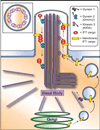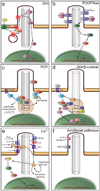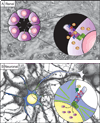The primary cilium as a cellular signaling center: lessons from disease
- PMID: 19477114
- PMCID: PMC2953615
- DOI: 10.1016/j.gde.2009.04.008
The primary cilium as a cellular signaling center: lessons from disease
Abstract
Genetic diseases known as ciliopathies have recently entered the limelight, placing new importance on a previously mysterious organelle: the primary cilium. Mutations affecting the primary cilium in both humans and animal models can lead to a plethora of distinct phenotypes including retinal degeneration, kidney cysts, and brain malformations. New findings are quickly lending insight into the functions of this cellular extension that seems to be especially important in modulation of subcellular signaling cascades at various stages of development and adult homeostasis.
Figures



References
-
- Fliegauf M, Benzing T, Omran H. When cilia go bad: cilia defects and ciliopathies. Nat Rev Mol Cell Biol. 2007;8:880–893. - PubMed
-
- Pedersen LB, Veland IR, Schroder JM, Christensen ST. Assembly of primary cilia. Dev Dyn. 2008;237:1993–2006. - PubMed
-
- Badano JL, Mitsuma N, Beales PL, Katsanis N. The ciliopathies: an emerging class of human genetic disorders. Annu Rev Genomics Hum Genet. 2006;7:125–148. - PubMed
-
- Adams NA, Awadein A, Toma HS. The retinal ciliopathies. Ophthalmic Genet. 2007;28:113–125. - PubMed
-
- den Hollander AI, Roepman R, Koenekoop RK, Cremers FP. Leber congenital amaurosis: genes, proteins and disease mechanisms. Prog Retin Eye Res. 2008;27:391–419. - PubMed
Publication types
MeSH terms
Grants and funding
LinkOut - more resources
Full Text Sources

